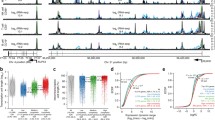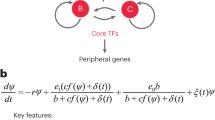Abstract
Cell differentiation and development are for a great part steered by cell type specific enhancers. Transcription factor (TF) binding to an enhancer together with DNA looping result in transcription initiation. In addition to binding motifs for TFs, enhancer regions typically contain specific histone modifications. This information has been used to detect enhancer regions and classify them into different subgroups. However, it is poorly understood how TF binding and histone modifications are causally connected and what kind of molecular dynamics steer the activation process.
Contrary to previous studies, we do not treat the activation events as static epigenetic marks but consider the enhancer activation as a dynamic process. We develop a mathematical model to describe the dynamic mechanisms between TF binding and histone modifications known to characterize an active enhancer. We estimate model parameters from time-course data and infer the causal relationships between TF binding and different histone modifications. We benchmark the performance of this framework using simulated data and survey the ability of our method to identify the correct model structures for a variety of system dynamics, noise levels and the number of measurement time points.
Access this chapter
Tax calculation will be finalised at checkout
Purchases are for personal use only
Similar content being viewed by others
References
Bishop, C.M.: Pattern Recognition and Machine Learning. Information Science and Statistics. Springer, Berlin (2006)
Calo, E., Wysocka, J.: Modification of enhancer chromatin: what, how, and why? Mol. Cell 49(5), 825–837 (2013)
Creyghton, M.P., et al.: Histone H3K27AC separates active from poised enhancers and predicts developmental state. Proc. Nat. Acad. Sci. 107(50), 21931–21936 (2010)
Friel, N., Wyse, J.: Estimating the evidence-a review. Stat. Neerl. 66(3), 288–308 (2012)
Fröhlich, F., Kaltenbacher, B., Theis, F.J., Hasenauer, J.: Scalable parameter estimation for genome-scale biochemical reaction networks. PLoS Comput. Biol. 13(1), e1005331 (2017)
Gelman, A., et al.: Bayesian Data Analysis, vol. 2, 2nd edn. Chapman & Hall/CRC, Boca Raton (2004)
Ghavi-Helm, Y., et al.: Enhancer loops appear stable during development and are associated with paused polymerase. Nature 512(7512), 96–100 (2014)
Girolami, M.: Bayesian inference for differential equations. Theor. Comput. Sci. 408(1), 4–16 (2008)
Hayashi, Y., et al.: Theoretical framework for the histone modification network: modifications in the unstructured histone tails form a robust scale-free network. Genes Cells 14(7), 789–806 (2009)
Heintzman, N.D., et al.: Distinct and predictive chromatin signatures of transcriptional promoters and enhancers in the human genome. Nat. Genet. 39(3), 311–318 (2007)
Kreutz, C., Raue, A., Kaschek, D., Timmer, J.: Profile likelihood in systems biology. FEBS J. 280(11), 2564–2571 (2013)
Lasserre, J., et al.: Finding associations among histone modifications using sparse partial correlation networks. PLoS Comput. Biol. 9(9), e1003168 (2013)
Le, N.T., Ho, T.B.: Reconstruction of histone modification network from next-generation sequencing data. In: 2011 IEEE 11th International Conference on Bioinformatics and Bioengineering (BIBE), pp. 181–188. IEEE (2011)
Meeker, W.Q., Escobar, L.A.: Teaching about approximate confidence regions based on maximum likelihood estimation. Am. Stat. 49(1), 48–53 (1995)
Natoli, G.: Maintaining cell identity through global control of genomic organization. Immunity 33(1), 12–24 (2010)
Oki, S., Otsuki, N., Kohsaka, T., Azuma, M.: Stat6 activation and Th2 cell proliferation driven by CD28 signals. Eur. J. Immunol. 30(5), 1416–1424 (2000)
Perner, J., et al.: Inference of interactions between chromatin modifiers and histone modifications: from chip-seq data to chromatin-signaling. Nucleic Acids Res. 42(22), 13689–13695 (2014)
Raue, A., et al.: Lessons learned from quantitative dynamical modeling in systems biology. PloS One 8(9), e74335 (2013)
Raue, A., et al.: Data2Dynamics: a modeling environment tailored to parameter estimation in dynamical systems. Bioinformatics 31(21), 3558–3560 (2015)
Schwarz, G.: Estimating the dimension of a model. Ann. Stat. 6(2), 461–464 (1978)
Stapor, P., et al.: PESTO: parameter estimation toolbox. Bioinformatics 34(4), 705–707 (2018). https://doi.org/10.1093/bioinformatics/btx676
Vahedi, G., et al.: Stats shape the active enhancer landscape of T cell populations. Cell 151(5), 981–993 (2012)
Voss, T.C., Hager, G.L.: Dynamic regulation of transcriptional states by chromatin and transcription factors. Nat. Rev. Genet. 15(2), 69–81 (2014)
Yu, H., et al.: Inferring causal relationships among different histone modifications and gene expression. Genome Res. 18(8), 1314–1324 (2008)
Zhou, J., Troyanskaya, O.G.: Global quantitative modeling of chromatin factor interactions. PLoS Comput. Biol. 10, e1003525 (2014)
Acknowledgements
We acknowledge the computational resources provided by Aalto Science-IT project.
Funding
This work has been supported by the Academy of Finland, project 275537 and Chan Zuckerberg Initiative.
Author information
Authors and Affiliations
Corresponding author
Editor information
Editors and Affiliations
Appendix
Appendix
Rights and permissions
Copyright information
© 2019 Springer Nature Switzerland AG
About this paper
Cite this paper
Nousiainen, K., Intosalmi, J., Lähdesmäki, H. (2019). A Mathematical Model for Enhancer Activation Kinetics During Cell Differentiation. In: Holmes, I., Martín-Vide, C., Vega-Rodríguez, M. (eds) Algorithms for Computational Biology. AlCoB 2019. Lecture Notes in Computer Science(), vol 11488. Springer, Cham. https://doi.org/10.1007/978-3-030-18174-1_14
Download citation
DOI: https://doi.org/10.1007/978-3-030-18174-1_14
Published:
Publisher Name: Springer, Cham
Print ISBN: 978-3-030-18173-4
Online ISBN: 978-3-030-18174-1
eBook Packages: Computer ScienceComputer Science (R0)




